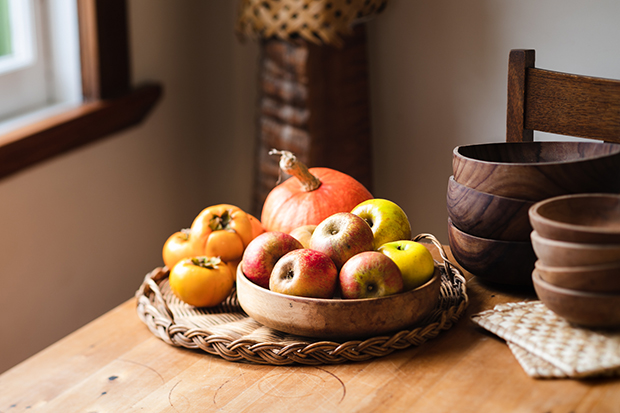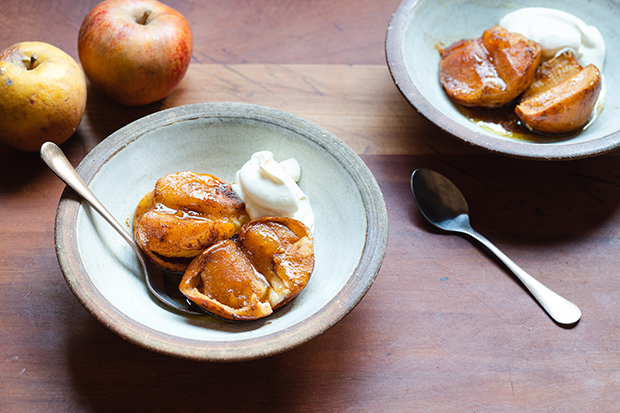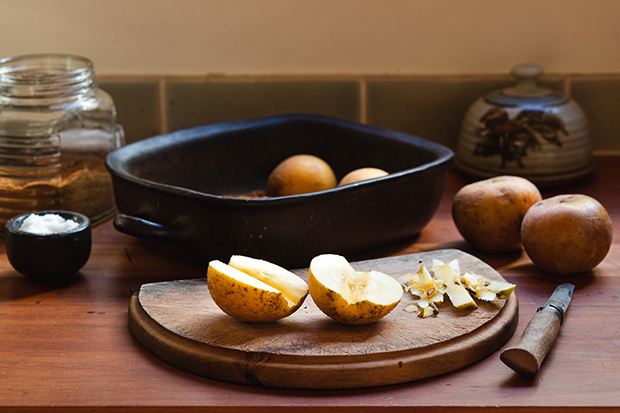Nicola Galloway: Caramel Baked Apples

Nicola makes the epitome of a cosy autumn dessert.
I am a big fan of heritage apples. Growing up in Nelson, apples were a common theme of my childhood. Unfortunately many orchards have since been removed to make way for housing developments and vineyards, but during the 80’s and 90’s (and earlier), apple growing was a big part of our local economy.
One of my first summer jobs was working on an apple orchard thinning apples. Paid by tree rather than the hour it was a gruelling job up and down apple trees on wobbly three leg ladders. But if you had swift fingers you could make around $12 an hour, a little above the minimum wage at the time. When you are young and nimble and earning your first paycheck this is pretty exciting.
These apples and the surrounding orchards in the Tasman area were destined for export. The apples were shiny and bright coloured, crisp and juicy to eat. Perfectly good fresh eating apples. But for cooking not so.
Spiralling back to an earlier apple memory with my Dutch grandma now, making applesauce (appelmoes) with green and red blushed apples from her garden in Christchurch. That house is long since gone from our family but I suspect the apples were a heritage variety such as boskoop or gravensteen. They weren’t bright and shiny, and from memory were always cooked and preserved into jars to line the outhouse shelves.
In the last decade or so I have come to appreciate these older apple varieties. We have a selection of local growers bringing in their interesting heritage apple harvests to sell at the produce markets. The apples come in an array of muted colours and textures. Some of them have a rough skin, these are the russets, knobbly looking apples that would be rejected on the supermarket shelf, but for those in the know are some of the most flavoursome apples you can find.
During my market visits in autumn I like to select a few apple varieties each week to cook. I will often cut a few slices to sample fresh, and although less juicy the complex flavours are just wonderful. Some of my favourites, and I know there are many more, include: Sturmer-pippin, Merton russet, Boskoop and Peasgood Nonsuch. In Nelson I source my heritage apples from Jeremy at Okainamu Organics and Rozmeri at Little Shaggery Farm. Keep an eye out at your local markets for heritage apples. Public fruit trees are also an option as many of these are older trees and the fruit is free to all. The varieties may be harder to identify but cook them up and enjoy the complex flavours.
Caramel Baked Apples

For these baked apples I halve the apples so they cook a little faster than whole apples. And being cooked cut side down they end up with the most wonderful caramelised surface. They still take time to cook and soften so I like to make these when I have the oven already to roast vegetables or a chicken for dinner.
The skin is left on to act as a container. Some heritage apple variety skins can be tough so simply scoop out the soft fresh when eating and compost the skin (or eat it all!). Serve with cream, yoghurt, custard or vanilla ice cream. Or scoop the apple flesh to serve over winter porridge. Delicious!
Prep time: 10 minutes
Cook time: about 45 minutes – depends on the apple variety used
Serves 4
INGREDIENTS
4 heritage apples – can use Granny Smith
40g butter
3 tbsp brown sugar
1 tsp cinnamon
pinch of salt

METHOD
Preheat the oven to 180C (fan 160C).
Cut the apples in half then carefully cut a v-shape to remove the core. Could also use a corer here and then halve the apples.
Select a baking dish that will snuggly fit the apple halves with their cut side down. Thinly slice the butter and arrange in the base of this dish. Sprinkle over the sugar, cinnamon, and salt. Arrange the apples cut side down onto the spiced butter. Cover with a lid or foil and bake for 30 minutes.
After this time remove the dish from the oven. Tip the dish so the juices run to the side and use a spoon to scoop up the juices and baste the top of each apple half. Return to the oven without the cover for another 10-15 minutes until the apples are tender when pierced with a knife.
The total cooking time will depend on the variety of apple. I used Merton Russets and they took 45 minutes.
Transfer the apples to serving bowls. Give the juices in the base of the dish a good mix as they can separate while cooking then spoon over the apples.
Add your chosen accompaniment – my favourite is lightly whipped cream and yoghurt spiked with a dash of vanilla extract.
Nicola Galloway is an award-winning food writer, cookbook author and culinary tutor. Find more seasonal recipes on her website – www.homegrown-kitchen.co.nz

